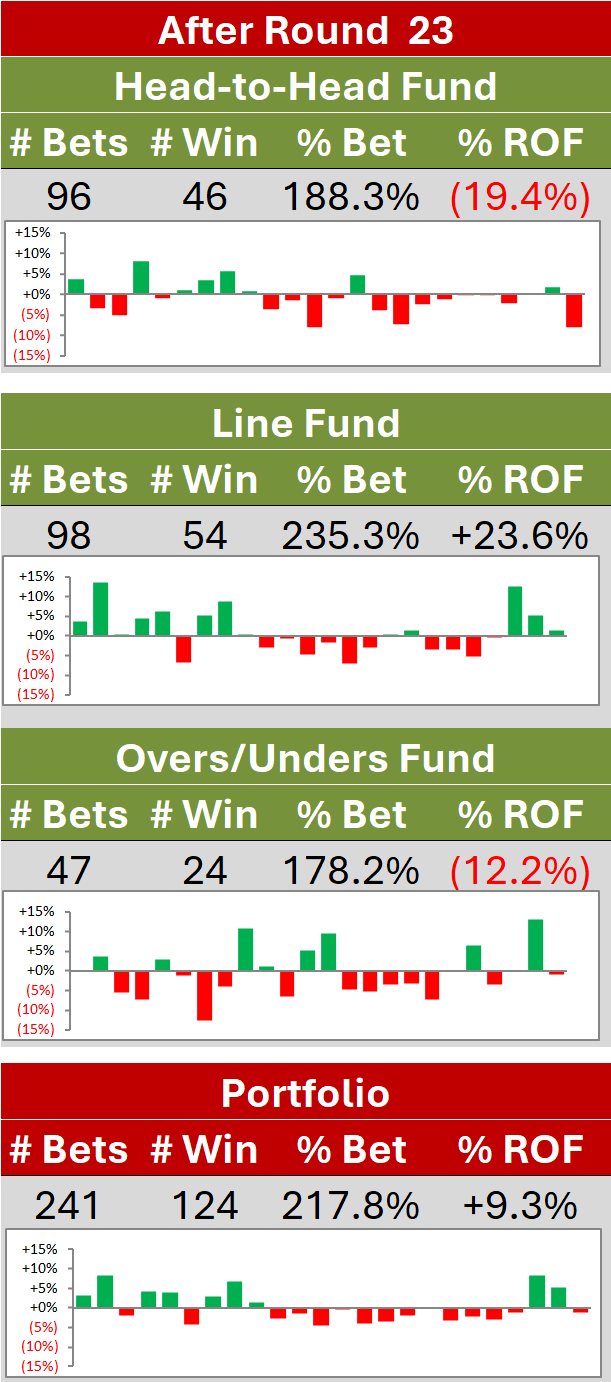Next, let's consider the four coefficients reflecting MoSSBODS ratings variables. We find, as hypothesised, that the coefficient for a team's own Offensive rating is positive and significant, and that for their opponent's Defensive rating is negative and significant.
Their size means that, for example, a team with a +1 Scoring Shot (SS) Offensive rating and a 0 SS Defensive rating playing a team with a 0 SS Defensive and Offensive rating would be expected to convert at 53.3%, which is just 0.2% higher than the rate in the 'reference game'. This is calculated as 1/1(1+exp(0.126+0.008)).
Strong Offensive teams will have ratings of +5 SS or even higher, in which case the estimated conversion rate would rise to just over 65%.
Similarly, a team facing an opponent with a +1 Scoring Shot (SS) Defensive rating and a 0 SS Offensive rating, itself having 0 SS Defensive and Offensive ratings would be expected to convert at 52.8%, which is about 0.3% higher than the rate for the 'reference game'.
The positive and statistically significant coefficient on a team's opponent's Offensive rating is a curious result. It suggests that teams convert at a higher rate themselves when facing an opposition with a stronger Offence.as compared to one with a weaker Offence. That opponent would, of course, be expected to convert at a higher-than-average rate itself, all other things being equal, so perhaps it's the case that teams themselves strive to create better scoring shot opportunities when faced with an Offensively more capable team, looking to convert less promising near-goal opportunities into better ones before taking a shot at goal.
In any case, the coefficient is only 0.004, about half the size of the coefficient on a team's own Offensive rating, and about one-third the size of that on the team's opponent's Defensive Rating, so the magnitude of the effect is relatively small.
To the venue-based variables then, where we see that three grounds have statistically significant coefficients. In absolute terms, Cazaly's Stadium's is largest, and negative, and we would expect a game played there between two 'average' teams, starting before 4:30pm in April to result in conversion rates of around 46%.
Docklands has the largest positive coefficient and there we would expect a game played between the same two teams at the same time to yield conversion rates of around 56%.
The coefficients on the Time of Day variables very much support the hypothesis that games starting later tend to have lower conversion rates. For example, a game starting between 4:30pm and 7:30pm played between 'average' teams at the MCG would be expected to produce conversion rates of just over 52%. A later-starting game would be expected to produce a fractionally lower conversion rate.
Month, it transpires, is also strongly associated with variability in conversion rates, with games played in any of the months May to August expected to produce higher conversion rates than those played in April. A game between 'average' teams, at the MCG, starting before 4:30pm and taking place in any of those months would be expected to produce conversion rates of around 54%, which is almost 1% point higher than would be expected for the same game in April. The Month variable then does not seem to be proxying for poorer weather.
Relatively few games in the sample were played in March (150) so, for the most part, April games were the first few games of the season. As such, the higher rates of conversion in other months might simply reflect an overall improvement in the quality and conversion of scoring shot opportunities once teams have settled into the new season.
Lastly, it turns out that attendance levels have virtually no effect on team conversion rates.
SUMMARY
It's important to interpret all of these results in the context of the model's pseudo R-squared, which is, again, around 2.5%. That means the vast majority of the variability in teams' conversion rates is unexplained by anything in the model (and, I would contend, potentially unexplainable pre-game). Any conversion rate forecasts from the model will therefore have very large error bounds. That's the nature of a measure as lumpy and variable as Conversion Rate, which can move by tens of percentage points in a single game on the basis of a few behinds becoming goals or vice versa.
That said, we have detected some fairly clear "signals" and can reasonably claim that conversion rates are:
- Positively associated with a team's Offensive rating
- Negatively associated with a team's opponent's Defensive rating
- Positively associated with a team's opponent's Offensive rating
- Higher (compared to the MCG) at Docklands, and lower at Cazaly's Stadium and Carrara
- Lower for games starting at 4:30pm or later compared to games starting before then
- Higher (relative to April) for games played between May and August
- Unrelated to attendance
Taken across a large enough sample of games, it's clear that these effects do become manifest, and that they are large enough, despite the vast sea of randomness they are diluted in, to produce detectable differences.
Next year I might see if they're large enough to improve MoSSBODS score projections because, ultimately, what matters most is if the associations we find prove to be predicitively useful.

